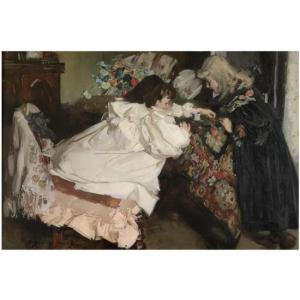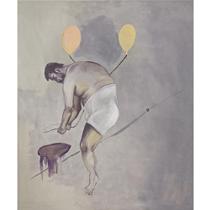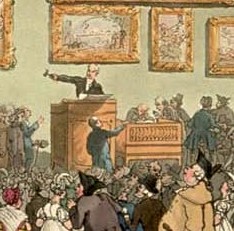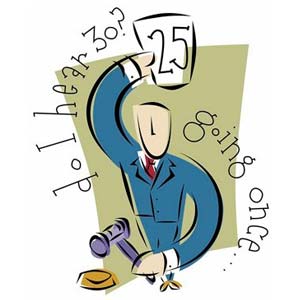How to Avoid Dirty Art Auction Tricks – artmarketblog.com
 Having focused my last few posts on the issues surrounding the questionable practices of some art auction houses, I thought it important to let people know how they can avoid becoming a victim of dirty art auction tricks and tactics. The only real way to avoid becoming a victim of the art auction houses is to ask questions and to know which questions to ask. Below is a list of questions, and the reasoning behind each question, that will ensure that you know exactly where you stand.
Having focused my last few posts on the issues surrounding the questionable practices of some art auction houses, I thought it important to let people know how they can avoid becoming a victim of dirty art auction tricks and tactics. The only real way to avoid becoming a victim of the art auction houses is to ask questions and to know which questions to ask. Below is a list of questions, and the reasoning behind each question, that will ensure that you know exactly where you stand.
Seven questions every buyer should ask before bidding on a work of art:
1. Does the auction house or anyone associated with the auction house have an ownership interest in the work of art I am thinking of purchasing?
(The reason you should ask this question is that if an auction house has an ownership interest in a work of art you should question whether this would have an effect on the way the auction house markets and presents the work of art in question – as well as the final price. Auction houses are required to indicate in auction catalogues when they have an ownership interest in a work of art.)
2. Is the auction house employee who is advising me on my purchases also representing the seller of the works they are advising me on?
(The reason you should ask this question is that it is not unknown for a specialist assigned to a particular client as an advisor to be representing the seller of the works they are advising the buyer to purchase. If you are assigned an expert advisor by an auction house make sure they are not representing the seller of the particular works you are interested in.)
3. Is there any doubt regarding the authenticity or provenance of the works of art I am interested in purchasing?
(The reason you need to ask this question is that auction houses are not always forthcoming with information regarding authenticity. It is worth while making sure that you are getting what you are paying for.)
4. Who has authenticated the works of art I am interested in purchasing, what qualifications do they have and what evidence was the authentication based on?
(The reason you need to ask this question is that auction houses have been known to justify the attribution they make using less than reliable information.)
5. When were the works of art I am interested in purchasing last consigned to an auction and what was the result?
(The reason that you should ask this question is that auction houses are not always forthcoming with information regarding the consignment history of a work of art. Auction houses have been known to sell the same work of art a number of times within a short period of time and not disclose this information to buyers. It is important to know this information as it is likely there is reason that this has occurred. It is also important to know this information because a work of art being passed in at auction can gain a stigma that can reduce the value.)
6. Does the auction house allow the auctioneer to bid in his own sale?
(It should be obvious why one needs to ask this question, and yes, some auction houses to allow the auctioneer to bid on their own sale.)
7. What is the condition of the works of art I am interested in purchasing and has a condition report been completed on each work?
(Auction houses are not always forthcoming with information regarding the condition of a work of art. It is generally expected that buyers will inspect a work of art themselves and will be aware of the condition of the work of art. If you are not able to assess the condition of a work of art then hire an expert.)
 **Nicholas Forrest is an art market analyst, art critic and journalist based in Sydney, Australia. He is the founder of http://www.artmarketblog.com, writes the art column for the magazine Antiques and Collectibles for Pleasure and Profit and contributes to many other publications
**Nicholas Forrest is an art market analyst, art critic and journalist based in Sydney, Australia. He is the founder of http://www.artmarketblog.com, writes the art column for the magazine Antiques and Collectibles for Pleasure and Profit and contributes to many other publications
Filed under: art, art auction, art investment, art market, christie's, contemporary art, fine art, sotheby's | Tagged: art auction, art market, artist, christie's, fine art, gallery, sotheby's | 1 Comment »






















 In Evaluating Art Auction Results Pt. 1 (see
In Evaluating Art Auction Results Pt. 1 (see 
 The first round of major art auctions for 09 have proven that there is still a considerable amount of money available to be spent on top quality and rare works of art provided the price is right. Fresh works from private collections appeared to be particularly sought after, a sign that solid and extensive provenance continues to be a big draw card. Even some of the less impressive works were eagerly fought over which suggests that the low prices and the excitement of the year’s first major auctions may have induced a bit of over-enthusiasm. The conservative estimates gave buyers plenty of reason to open their wallets and the smaller sales encouraged healthy competition for the top works.
The first round of major art auctions for 09 have proven that there is still a considerable amount of money available to be spent on top quality and rare works of art provided the price is right. Fresh works from private collections appeared to be particularly sought after, a sign that solid and extensive provenance continues to be a big draw card. Even some of the less impressive works were eagerly fought over which suggests that the low prices and the excitement of the year’s first major auctions may have induced a bit of over-enthusiasm. The conservative estimates gave buyers plenty of reason to open their wallets and the smaller sales encouraged healthy competition for the top works.


















